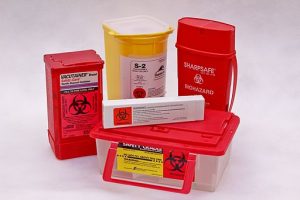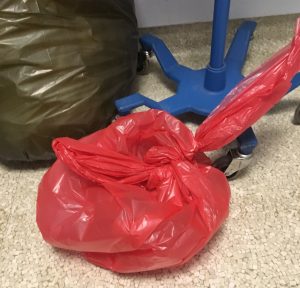Healing Healthcare’s Waste Problem
Deborah Saber works to bring sustainable practices to hospital waste disposal
In 2016, registered nurse Deborah Saber came to the University of Maine from Miami, Florida where she worked on problems related to the disposal of solid waste materials from infectious hospitalized patients.
Now a UMaine assistant professor of nursing, Saber found her way to the Mitchell Center’s Materials Management team and brought a new area of expertise to the interdisciplinary group whose research seeks to reduce the environmental, social, and economic impacts of materials use.

As Saber wrote in the inaugural issue of Spire, UMaine’s Journal of Conservation and Sustainability, the need for continued research on the solid waste disposal processes used in caring for infectious hospitalized patients is due in part to the fact that current disposal processes were implemented in the 1980s when the focus was on preventing contagion from human blood and blood contaminated products.
“Medical solid waste challenges have evolved over the last three decades, and now include a need to address the spread of multi-drug resistant organisms, or MDROs,” says Saber.
Adding to the challenges are the increasing complexity of conditions and the occurrence of two or more chronic diseases or conditions in patients that may require multiple procedures. Also, according to Saber, there is a need to address the rapidly increasing use of disposable patient care products that enter the waste stream.
According to Saber, hospitals have a vested interest in developing safe, efficient, and sustainable protocols for processing, transporting, and disposing of biomedical waste that is produced while caring for patients with infectious diseases.
“Developing strategies for minimizing the spread of infectious diseases will facilitate modernization of solid waste disposal processes to address emerging issues while supporting environmental health and sustainability,” Saber says.
Saber’s interest in the field was first sparked when the Ebola virus disease showed up in Florida in 2014 highlighting the mishandling of waste disposal. Her research at that point focused on determining just how much waste was generated by a patient being treated in an MDRO isolation room.

Using two MDRO patients for her initial study, she found that roughly 43 percent of the waste from these rooms was just from the isolation precaution garb donned by caregivers. “But,” she says, “those gowns and gloves also go into the unregulated waste bin that can be sent to landfills. So not only do we have this potentially contaminated material going into landfills, but there’s an awful lot of waste.”
“Are we producing all this solid waste needlessly?” Saber asks adding, “I believe our isolation procedures need to be reevaluated for their efficacy.”
Saber also believes that developing a model that could help to categorize when specific patients actually require isolation would also cut down on waste production. This is something she hopes to work on in the future.
Hospital food waste
Saber is also focusing on a growing area of interest and research for the Materials Management team—food waste—saying she has “morphed” her hospital research to include the examination of this waste source.
As part of a new grant from UMaine’s Interdisciplinary Undergraduate Research Collaboratives Program, Saber, along with an undergraduate student researcher, will analyze food waste practices in a hospital environment from both plate waste and kitchen waste. Her methodology will include observational and quantitative data collection via field notes, checklists, interviews at the food preparation site and after food consumption from patients.
“Debbie’s applied perspective and experience in the healthcare industry reminds us how much is at stake as we work with our community partners to create materials and waste management systems that are more sustainable.” —Cindy Isenhour

“Right now in hospitals, unused food just goes into the waste stream. We really have to start thinking about it at a higher level in hospitals and incorporate more sustainable practices,” Saber says. “Restaurants think about it a little bit more, campuses think about composting and recycling, but I don’t think hospitals are quite there yet, and hospitals produce over 70 percent of all the solid waste (including food waste) that is produced by the healthcare industry”
She says the recent grant funding—one of only five chosen out of 31 proposals—was made possible because the Materials Management team, which is comprised of researchers from nursing, anthropology, engineering, health, food science, economics, and psychology, work closely together to examine food waste.
“Our highly supportive, collaborative, interdisciplinary team was ideally positioned to apply for this grant,” Saber says. And on a personal note, Saber adds that the team has provided her with critical development as a scientist. “My focus of research expanded as I learned about the breadth of waste production—solid waste and food—and implications for ecological and human sustainability.”
Notes Cindy Isenhour, assistant professor in the UMaine Department of Anthropology and co-leader of the Materials Management team, “We had several different disciplines represented from the social, physical, and natural sciences on the team and Debbie’s applied perspective and experience in the healthcare industry reminds us how much is at stake as we work with our community partners to create materials and waste management systems that are more sustainable”
—David Sims
